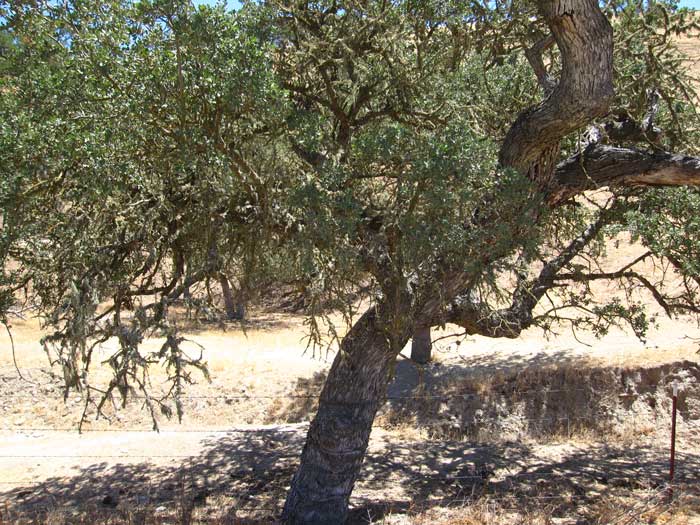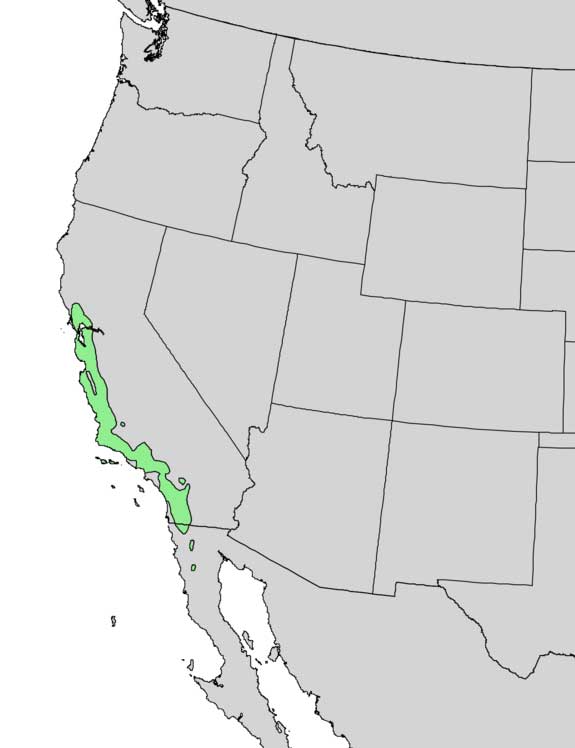Ethnobotany of southern California native plants:
California Live Oak (Quercus agrifolia)

The California live oak acorn, a favorite food source for local Native Americans.

credit: PeterOMalley, CC BY-SA 3.0
Live oak growing happily on a south facing slope in a chaparral valley.

Geographic range of California live oak.
California Live Oak (Quercus agrifolia)
California live oak, or coast live oak, is an evergreen species from the Fagaceae family. It grows on the west side of the Sierra Nevada and Coast Range mountains from about San Francisco south to northern Baja.
This oak tree has a distinct look. The trunk produces many branches, creating a full, rounded crown. The tree is generally between 20-70 feet tall. Live oak leaves are dark green and oval. The leaves have a spiny-toothed margin, a serrated look.
The live oak is a dominant plant throughout the chaparral and pine/oak woodlands of southern California. The acorns of this tree were an important food source for Native Americans. At least 12 different Native American groups in California considered the live oak acorn to be a main dietary staple.
Preparing acorn meal from the live oak
Acorns were gathered from the end of the summer up to December. Once collected, acorns could then be stored in primitive granaries. These acorns could last up to a year.
To prepare the acorns for consumption, native people would grind the seeds into a milled power. A morter and metate was used to break up the acorn seeds. Tannins were then leached out to improve the taste of the acorns. Once reduced to a flour, the acorn meal could be mixed with water to make a bread or cake or an acorn gruel. This acorn powder was sometimes toasted and brewed with water to serve as a form of coffee.
Live oak was considered the primary food source of the Kumeyaay and the Cahuilla. They ground acorns into a fine meal for bread-making. The Cahuilla also boiled acorn meal with water to produce an edible mush.
This acorn meat was considered a delicacy. It was used at special ceremonial occasions. Cahuilla people used acorn meat as a means to repay their shamans for services provided.
When Cahuilla people were out hunting small game, they would use live oak acorns for trap bait.
Luiseno people also gathered acorns extensively. They stored acorns in primitive granaries for long term use.
The Mahuna people used the plant as a hemostat, to address newborns and bleeding navels.
A non-traditional use of these acorns was as a noisemaker. The Cahuilla occasionally tied acorns to a string, then swung the acorns at their teeth to make a clacking sound.
The Kumeyaay made a decoction from the chipped bark of live oak. This preparation was then used as an antiseptic, for cleaning sores.
Early European settlers also utilized the live oak.
When the Spanish arrived in the 17th Century, they began using live oak wood to fire up their kilns. These kilns were necessary for making adobe bricks, the main structural unit to their homes. Charcoal from burned oak wood was eventually used by Spaniards for baking and gunpowder.
Due to the gnarled shape of the trunk and branches, the live oak was not a favorite tree for lumber. In some respects, this fact has preserved the oak. Other, more lumber-friendly trees, got systematically harvested when Americans arrived to build the cities of LA, San Diego and San Francisco.
Interestingly, shipbuilders appreciated the crooked branches, as they could use these sections of wood for odd, irregular joints on their boat designs.
Looking for a book that will connect you with the wild elements of this planet?
Here’s my recommended reading list.
Warning: All of my books contain a botany, ethnobotany or drug discovery component.
References:
Bocek, Barbara R. 1984 Ethnobotany of Costanoan Indians, California, Based on Collections by John P. Harrington. Economic Botany 38(2):240-255 (p. 248)
Sparkman, Philip S. 1908 The Culture of the Luiseno Indians. University of California Publications in American Archaeology and Ethnology 8(4):187-234 (p. 194)
Please return to our main Ethnobotany of southern California page.
On our main ethnobotany page, we present a clickable list of the southern California native plants that became a part of the culture of Native Americans and early European settlers. These plants were used for medicine, food, shelter, drink, tools and art.
Warning: The information about plants on this website is intended for general educational purposes only. The author of this website accepts no responsibility for problems arising from the user’s misidentification, misuse, or use of plants. Please read the full TERMS associated with this website.
